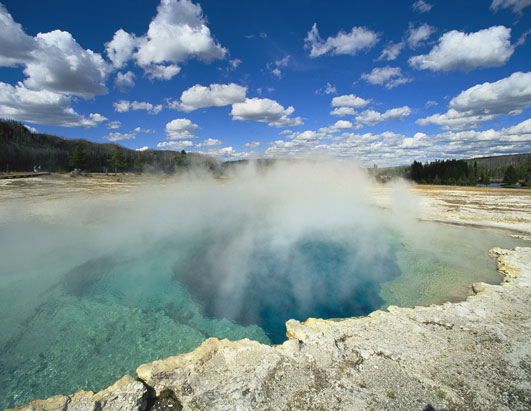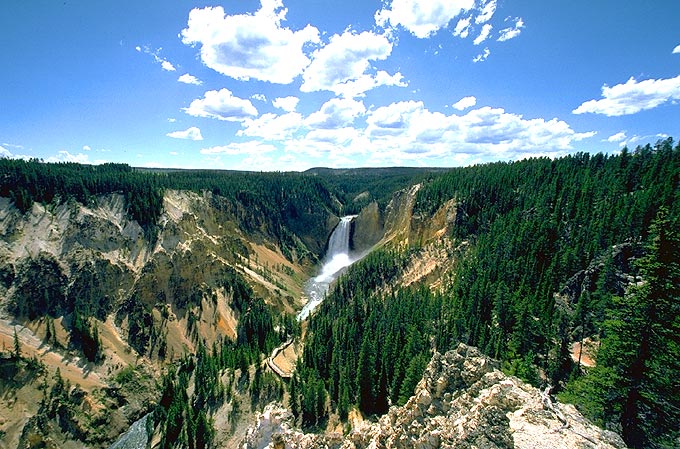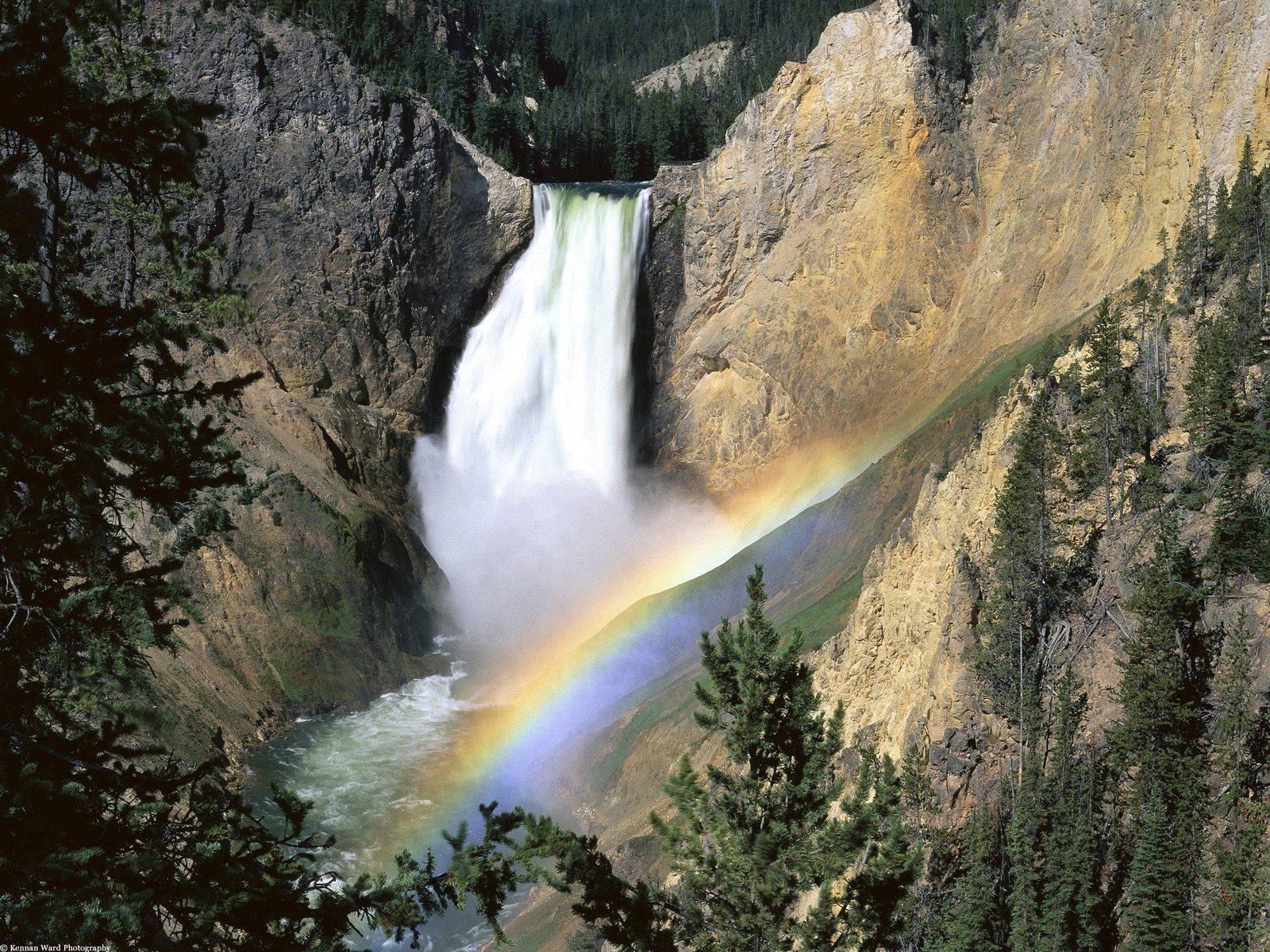Yellowstone National Park is locate in Northwest corner of the State of Wyoming and relatively small adjacent areas of the States of Montana and Idaho -
N 44 27 38 W 110 49 40
It covers 898349 ha.
The vast natural forest of Yellowstone National Park covers nearly 9,000 km2; 96% of the park lies in Wyoming, 3% in Montana and 1% in Idaho. Yellowstone contains half of all the world's known geothermal features, with more than 10,000 examples. It also has the world's largest concentration of geysers (more than 300 geyers, or two thirds of all those on the planet). Established in 1872, Yellowstone is equally known for its wildlife, such as grizzly bears, wolves, bison and wapitis.
Yellowstone's Ancient Supervolcano
The geysers of Yellowstone National Park owe their existence to the "Yellowstone hotspot"--a region of molten rock buried deep beneath Yellowstone, geologists have found.
But how hot is this "hotspot," and what's causing it?
In an effort to find out, Derek Schutt of Colorado State University and Ken Dueker of the University of Wyoming took the hotspot's temperature.
The scientists published results of their research, funded by the National Science Foundation (NSF)'s division of earth sciences, in the August, 2008, issue of the journal Geology.
"Yellowstone is located atop of one of the few large volcanic hotspots on Earth," said Schutt. "But though the hot material is a volcanic plume, it's cooler than others of its kind, such as one in Hawaii."
When a supervolcano last erupted at this spot more than 600,000 years ago, its plume covered half of today's United States with volcanic ash. Details of the cause of the Yellowstone supervolcano's periodic eruptions through history are still unknown.
Thanks to new seismometers in the Yellowstone area, however, scientists are obtaining new data on the hotspot.
Past research found that in rocks far beneath southern Idaho and northwestern Wyoming, seismic energy from distant earthquakes slows down considerably.
Using the recently deployed seismometers, Schutt and Dueker modeled the effects of temperature and other processes that affect the speed at which seismic energy travels. They then used these models to make an estimate of the Yellowstone hotspot's temperature.
They found that the hotspot is "only" 50 to 200 degrees Celsius hotter than its surroundings.
"Although Yellowstone sits above a plume of hot material coming up from deep with the Earth, it's a remarkably 'lukewarm' plume," said Schutt, comparing Yellowstone to other plumes.
Although the Yellowstone volcano's continued existence is likely due to the upwelling of this hot plume, the plume may have become disconnected from its heat source in Earth's core.
"Disconnected, however, does not mean extinct," said Schutt. "It would be a mistake to write off Yellowstone as a 'dead' volcano. A hot plume, even a slightly cooler one, is still hot."
-Yellowstone recently Earthquakes
From 1,000 to 3,000 earthquakes typically occur each year within Yellowstone National Park and its immediate surroundings. Although most are too small to be felt, these quakes reflect the active nature of the Yellowstone region, one of the most seismically active areas in the United States. Each year, several quakes of magnitude 3 to 4 are felt by people in the park.
Although some quakes are caused by rising magma and hot-ground-water movement, many emanate from regional faults related to crustal stretching and mountain building. For example, major faults along the Teton, Madison, and Gallatin Ranges pass through the park and likely existed long before the beginning of volcanism there. Movements along many of these faults are capable of producing significant earthquakes. The most notable earthquake in Yellowstone’s recent history occurred in 1959. Centered near Hebgen Lake, just west of the park, it had a magnitude of 7.5. This quake caused $11 million in damage (equivalent to $70 million in 2005 dollars) and killed 28 people, most of them in a landslide that was triggered by the quake.
Geologists conclude that large earthquakes like the Hebgen Lake event are unlikely within the Yellowstone Caldera itself, because subsurface temperatures there are high, weakening the bedrock and making it less able to rupture. However, quakes within the caldera can be as large as magnitude 6.5. A quake of about this size that occurred in 1975 near Norris Geyser Basin was felt throughout the region.
Even distant earthquakes can affect Yellowstone. In November 2002, the magnitude 7.9 Denali Fault earthquake struck central Alaska, 1,250 miles (2,000 km) northwest of Yellowstone. Because this quake’s energy was focused toward the active Yellowstone volcanic and hydrothermal system, it triggered hundreds of small earthquakes there. The region’s hydrothermal system is highly sensitive to quakes and undergoes significant changes in their wake. Earthquakes may have the potential to cause Yellowstone’s hot-water system to destabilize and produce explosive hydrothermal eruptions.
During the month of February 2005, 61 earthquakes were located in the Yellowstone region. The largest of these shocks was a magnitude 2.8 on February 22, 2005 at 6:49 PM MST, located about 9.1 miles north northwest of Madison Junction, Wyoming. No earthquakes in this period were reportedly felt.
Earthquake activity in the Yellowstone region is at relatively low background levels.











But how hot is this "hotspot," and what's causing it?
In an effort to find out, Derek Schutt of Colorado State University and Ken Dueker of the University of Wyoming took the hotspot's temperature.
The scientists published results of their research, funded by the National Science Foundation (NSF)'s division of earth sciences, in the August, 2008, issue of the journal Geology.
"Yellowstone is located atop of one of the few large volcanic hotspots on Earth," said Schutt. "But though the hot material is a volcanic plume, it's cooler than others of its kind, such as one in Hawaii."
When a supervolcano last erupted at this spot more than 600,000 years ago, its plume covered half of today's United States with volcanic ash. Details of the cause of the Yellowstone supervolcano's periodic eruptions through history are still unknown.
Thanks to new seismometers in the Yellowstone area, however, scientists are obtaining new data on the hotspot.
Past research found that in rocks far beneath southern Idaho and northwestern Wyoming, seismic energy from distant earthquakes slows down considerably.
Using the recently deployed seismometers, Schutt and Dueker modeled the effects of temperature and other processes that affect the speed at which seismic energy travels. They then used these models to make an estimate of the Yellowstone hotspot's temperature.
They found that the hotspot is "only" 50 to 200 degrees Celsius hotter than its surroundings.
"Although Yellowstone sits above a plume of hot material coming up from deep with the Earth, it's a remarkably 'lukewarm' plume," said Schutt, comparing Yellowstone to other plumes.
Although the Yellowstone volcano's continued existence is likely due to the upwelling of this hot plume, the plume may have become disconnected from its heat source in Earth's core.
"Disconnected, however, does not mean extinct," said Schutt. "It would be a mistake to write off Yellowstone as a 'dead' volcano. A hot plume, even a slightly cooler one, is still hot."
-Yellowstone recently Earthquakes
From 1,000 to 3,000 earthquakes typically occur each year within Yellowstone National Park and its immediate surroundings. Although most are too small to be felt, these quakes reflect the active nature of the Yellowstone region, one of the most seismically active areas in the United States. Each year, several quakes of magnitude 3 to 4 are felt by people in the park.
Although some quakes are caused by rising magma and hot-ground-water movement, many emanate from regional faults related to crustal stretching and mountain building. For example, major faults along the Teton, Madison, and Gallatin Ranges pass through the park and likely existed long before the beginning of volcanism there. Movements along many of these faults are capable of producing significant earthquakes. The most notable earthquake in Yellowstone’s recent history occurred in 1959. Centered near Hebgen Lake, just west of the park, it had a magnitude of 7.5. This quake caused $11 million in damage (equivalent to $70 million in 2005 dollars) and killed 28 people, most of them in a landslide that was triggered by the quake.
Geologists conclude that large earthquakes like the Hebgen Lake event are unlikely within the Yellowstone Caldera itself, because subsurface temperatures there are high, weakening the bedrock and making it less able to rupture. However, quakes within the caldera can be as large as magnitude 6.5. A quake of about this size that occurred in 1975 near Norris Geyser Basin was felt throughout the region.
Even distant earthquakes can affect Yellowstone. In November 2002, the magnitude 7.9 Denali Fault earthquake struck central Alaska, 1,250 miles (2,000 km) northwest of Yellowstone. Because this quake’s energy was focused toward the active Yellowstone volcanic and hydrothermal system, it triggered hundreds of small earthquakes there. The region’s hydrothermal system is highly sensitive to quakes and undergoes significant changes in their wake. Earthquakes may have the potential to cause Yellowstone’s hot-water system to destabilize and produce explosive hydrothermal eruptions.
During the month of February 2005, 61 earthquakes were located in the Yellowstone region. The largest of these shocks was a magnitude 2.8 on February 22, 2005 at 6:49 PM MST, located about 9.1 miles north northwest of Madison Junction, Wyoming. No earthquakes in this period were reportedly felt.
Earthquake activity in the Yellowstone region is at relatively low background levels.














 12:30 PM
12:30 PM
 crkota
crkota






 Posted in:
Posted in: 


0 comments:
Post a Comment